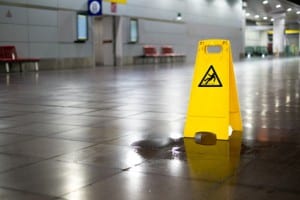 Most contracts for commercial cleaning include cleaning floors on a routine basis. In large, and even small commercial and industrial facilities, floors undergo strenuous circumstances – this includes a lot of traffic, spills by customers and employees, marks from shoes, as well as other wear and tear. Although this is a standard issue in commercial cleaning, there are mistakes that make the task of floor cleaning even harder. As the saying goes for many types of businesses; “time is money”. Spending a few minutes to properly maintain floors can assist you in the long-run and keep your customers happy.
Most contracts for commercial cleaning include cleaning floors on a routine basis. In large, and even small commercial and industrial facilities, floors undergo strenuous circumstances – this includes a lot of traffic, spills by customers and employees, marks from shoes, as well as other wear and tear. Although this is a standard issue in commercial cleaning, there are mistakes that make the task of floor cleaning even harder. As the saying goes for many types of businesses; “time is money”. Spending a few minutes to properly maintain floors can assist you in the long-run and keep your customers happy.
Using the Wrong Products
While some floor types, such as linoleum and tile are standard in commercial and industrial facilities, it’s important to ask the client about each of the floors in their buildings. If you assume the floor is one type and not another, it can lead you to use a product that isn’t correct for the floor type. In most cases, a neutral floor cleaner, such as Worldwide Janitor’s All Purpose Neutral Cleaner works on almost any type of floor.
Select the appropriate floor cleaning products and use the proper dilution ratios. If the client is unsure about the textile of the floor surface, use a neutral floor cleaner. For surfaces such as marble, a rayon mop, hot water and properly diluted neutral floor cleaner assists in keeping the floor’s luster. Use a microfiber dust cloth or floor buffer to dry marble floor and avoid streaks.
Overusing Floor Products and Chemicals
As suggested in one of Worldwide Janitor’s previous article, proper dilution ratios can not only save you money, overuse of floor products can also make a mess of floors. Floors can look dull or unclean and require additional services, such as stripping, sealing and waxing more often. Although most customers don’t understand the work you and your employees put into cleaning floors, they will complain about floors being dingy, or floors that look like you never attempted to clean them. By using the proper amount of floor cleaning products and understanding dilution ratios, the floors can be maintained properly.
Not Preparing the Floors for Cleaning
In many cases, a quick dust mop can prepare a floor for mopping. Worldwide Janitor’s Dust Mist works well with a dust mop to remove the dust from floors. Floors can accumulate dust and debris around the edges and in corners as well. That can result in respreading dirt around and require additional mopping, making the job harder. It also makes your equipment dirty. Depending on the size of the area, it only takes a few additional minutes to remove the dust and debris in areas a dust mop can’t reach. Use an angled broom to clean areas, such as baseboards and corners before mopping the floor surface. This also assists in stripping, sealing and waxing.
Not Properly Cleaning the Equipment Used to Apply Cleaning Products
Dirty equipment can’t really clean a dirty floor. For smaller floor surfaces, you may not need to rinse your mop and clean the mop bucket while you’re mopping. For larger floor surfaces, it’s critical to ensure the water and mop is clean. After the mopping process, ensure your mop bucket is clean by rinsing it out aggressively. Ring out the mop, then rinse the ringer. Remove the ringer and clean out the mop bucket. When the mop bucket is thoroughly cleaned, refill it and add a small amount of bleach. Replace the ringer and mop and allow the bleach to clean the mop, ringer and bucket. You can also purchase a smaller mop bucket specifically used to clean the mop while you’re mopping the floors. Simply fill the smaller mop bucket with warm water to clean the mop. This extends the life of your mops and mop buckets.
Avoiding Routine Aggressive Cleaning
Even if you’re cleaning contract doesn’t include stripping, sealing, waxing or buffing floors, suggest to your clients that at this type of cleaning is required to maintain their floors. Consider speaking to your client about adding those services to ensure floors maintain their shine and sanitation. No matter how much you clean, service your equipment and use the correct cleaning products for specific floor types, general wear and tear will eventually wear down the floors and make them look dull.
On tile floors often found in bathrooms and kitchens, the grout will become dingy, requiring maintenance to obtain its clean appearance. Because grout is often used in bathrooms, it can present an unclean appearance to employees and customers. Take the time to scrub the tile and grout with a grout scrub brush. It doesn’t have to be done daily, but can be done weekly or monthly, depending on the traffic in the area. Scrubbing floors assists in the more aggressive cleaning process on a routine basis.





